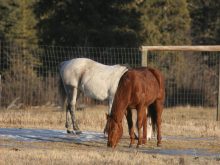Ticks seem to be expanding their territory in North America and are trending north. Animal movement facilitates this but climate change and adaptation may play a role.
With ticks comes fear of potential diseases they may carry. Then there is blood loss, irritation, and performance losses in cattle if numbers get too high.
Most ticks have complicated life cycles and multiple hosts so they are hard to control, and most insecticides are only residual for a certain time so retreatment may be necessary.
Read Also

Beef cattle more prone to trace mineral deficiencies
The trace mineral status of our cows and calves is a significant challenge for western Canadian producers and veterinarians.
If you find ticks in your cattle herd, find out the species and see if there is an approved product or two or three that have tick control on the label.
See what your veterinarian recommends, but depending on time of year, it may reach the point where the ticks naturally fall off and treatment may not be necessary.
Certain species in certain regions can cause tick paralysis so those are worthy of note. Cases are prevalent in certain areas of B.C. and Manitoba. Producers try to treat at the most appropriate times but a single treatment may not provide full protection.
In Western Canada, the two main ticks on cattle or horses are wood ticks, which we see after the snow melt until about the end of May, and the winter tick, also called the moose tick, that we see on animals in the fall.
Winter ticks are sometimes seen in massive numbers, causing lots of mortality in moose in bad years. Often the numbers on cattle or horses aren’t that high.
Now is the time to watch for ticks by checking animals around the ears, under the tail, between the hind legs and in the folds of the udder.
Ticks are most likely discovered when processing cattle or grooming horses. Individual ticks can be removed from horses but if there are high numbers in cattle, discuss treatment with your veterinarian.
Farmers and ranchers who see large tick loads learn which pastures or areas are most contaminated; usually protected areas with lots of cover and high grass. Then they avoid pasturing cattle in those areas at times when ticks are most prevalent.
Severe infestations lead to blood loss and anaemia. A veterinarian can advise on the best parasiticide. Most are pour-on products and several are recommended for cattle. Winter tick treatment is best done in the fall and corresponds with treatments for lice and warbles, and those products generally work on ticks as well.
A new product for ticks has been approved in South Africa, I believe, since that country has an abundance of ticks in many species.
As the tick range gradually moves north, species identification becomes more important. It’s good to communicate with fish and wildlife comrades because they often monitor for diseases and parasites on animals they capture to collar.
They say moose get an abundance of winter ticks at times because they don’t groom that much, whereas elk have a lower level and deer have almost no ticks because they groom very well.
I’m not sure where cattle stand in this regard but my guess is somewhere in the middle. Calves are groomed well by their mothers but keep an eye on them as well.
The long-horned tick has never been seen in Canada but was introduced into the U.S. from Asia. It is in many eastern states and is potentially moving north. They say the climate in southern Ontario is right for this tick as it prefers heat and humidity.
This type of tick can spread a disease called Theileria orientalis, which causes anaemia, weakness and a drop in milk production. Infestation can occur with the import of feeder cattle from Virginia or other U.S. states where the tick has established. Identification is key.
Ticks are fairly visible and seem to be proliferating. Watch for them, identify the species and treat when necessary and at the right time for control.
There are helpful tools on the eTick website at www.etick.ca.
Roy Lewis works as a veterinarian in Alberta.















